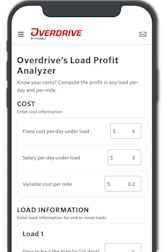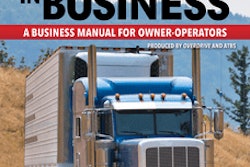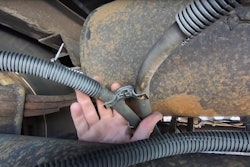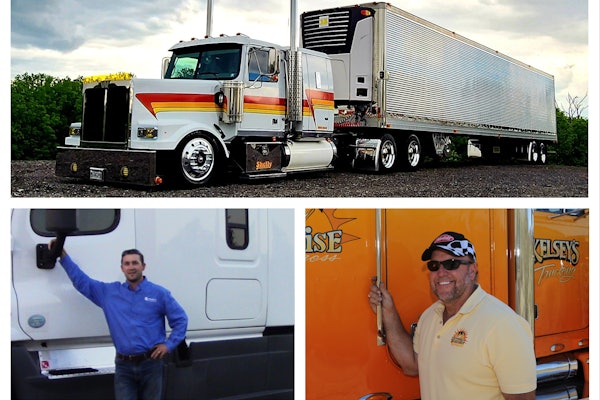Sunday, Aug. 24, the Commercial Vehicle Safety Alliance's annual Brake Safety Week inspection blitz and outreach/education event kicks off with an increased emphasis on that oh-so-crucial component in any owner-operator's rig. Inspection likelihood should be up around the nation, but new analysis of data with Overdrive's sister company RigDig Business Intelligence offers a clue toward pinpointing where a brake-related violation is most likely.
No state is more focused on braking systems than North Dakota, with almost a full third of total violations issued during calendar year 2024 in the brakes category. Here's the top-10 list for brake violation intensity among states, with some big states among them. (State names in bold also appear in the top 10 for equipment/maintenance violations generally. Safe to expect close attention to the truck in those states.)
- North Dakota
- Texas
- Utah
- Wyoming
- Oklahoma
- California
- Maine
- Minnesota
- Idaho
- Vermont
Here's how the brakes-violation picture shakes out nationally. Brakes-violation percentages, again, are based on data for calendar-year 2024 mined by our RigDig Business Intelligence sister company, provider of Overdrive's Truck History Reports.
Since we last charted the toughest brakes-violation issuers among states based on data from 2021, there's been some reshuffling at the top of the list, but North Dakota holds onto its No. 1 spot. Second- and third-place finishers Texas and Utah have moved up in the top 10 rankings, meantime.

Texas Department of Public Safety Major Omar Villareal in part explained Texas' rise up the rankings by pointed to the state's eight border inspection facilities, staffed both with state troopers as well as civilian truck inspectors" he said. The facilties are well-equipped to "conduct Level I inspections" of incoming equipment. "Every week is 'Brake Safety Week'" there, he added.
Outside Texas, the other two states' lead Motor Carrier Safety Assistance Program (MCSAP) agencies didn't respond to queries about what might explain their intensity of focus other than a bevy of brake-function problems there, but suffice it to say if there's a brake-related violation to be found, they're quite likely find it.
This year with Brake Safety Week, the topic area of focus for inspectors is drums and rotors, generally speaking, though standard inspections will still certainly involve all the truck and trailer's systems as usual.
During the April unannounced "Brake Safety Day" inspections, enforcement jurisdictions that participated focused on drums and rotors, too. As reported previously here in Overdrive, of 4,569 inspections conducted that day, April 22, about 9 in every 10 had no brakes-related out-of-service violations. A total of 8% of the trucks inspected, then, had drum/rotor-related violations in particular, with about half of those OOS violations.
Download CVSA's tip sheet on drum/rotor inspections released ahead of Brake Safety Week here.
Owner-operators who stay on top of equipment maintenance, generally speaking, ought to run free and clear. Chances of inspection remain generally low, even during an inspection "blitz" event like this coming week's. How likely are you to be inspected during Brake Safety Week? If rates seen last year repeat themselves, there's a 15% chance of some kind of inspection, less than that for one of the truck itself.
That's what we found when, as the brakes-inspection event wrapped up, we asked owner-operators whether they'd been inspected during the week. Yes answers to the question were fairly hard to come by:
Wrinkle in the mix: Performance-Based Brake Testers
During the unannounced Brake Safety Day inspection event in April, as we reported in June, 100 trucks and truck-trailer combos were tested with a so-called Performance-Based Brake Tester. PBBTs are described in part this way by CVSA:
A Performance-Based Brake Tester (PBBT) measures the slow speed brake force and weight at each wheel, adds up the total vehicle brake force, and divides it by the total vehicle weight to determine overall vehicle braking efficiency. U.S. federal regulations and the North American Standard Out-of-Service Criteria require a minimum braking efficiency of 43.5%. If your vehicle’s braking efficiency is below 43.5%, your brakes are in need of service because they are not providing the minimum stopping power required and are performing poorly.
Measure below 43.5% and you're out of service, as were 8 of the 100 vehicles measured with a PBBT during that April brakes-inspection day. Keep in mind, though, that's a rate slightly below the roughly 10% brake-out-of-service rate for total trucks inspected as part of the effort that day.
In 2020, PBBTs were in operation in several U.S. states, and today the number has climbed to approach half of all the states at 20, according to CVSA's Nicole Leandro this week. Some of those (in bold) are on the top 10 toughest brakes states list: Colorado, Florida, Georgia, Indiana, Iowa, Kansas, Maine, Massachusetts, Minnesota, Michigan, Montana, Nebraska, New Jersey, New York, North Dakota, Oklahoma, South Dakota, Utah, Wisconsin, Wyoming.
Some Canadian jurisdictions, too.
With the Brake Safety Week initiative, CVSA noted in press materials, inspectors using PBBTs planned to submit brake-performance data for analysis to CVSA, which itself is planning to report the results. Keep an eye on the out-of-service rate there versus the larger pool of trucks inspected with OOS brakes violations. If the PBBTs provide an accurate performance measure, might results point the way to adjustments aimed at refining OOS conditions?
If you yourself see a PBBT this coming week (read this if you're a liquid-bulk hauler), reach out and get in touch about your own results.
[Related: Performance-Based Brake Testers and liquid freight]
More brakes- and inspections-related resources:
- Tips to avoid brake violations ahead of Brake Safety Week
- Stay ahead of the inspectors with maintenance topics in Overdrive
- How brake-adjustment alone can put you out of service -- the '20% rule'
Ways to avoid inspection, without bypassing the scales
- CVSA out-of-service criteria updates for 2025, 2024 and 2023
- Invest in inspections now to save money, hassle later
- Inspections, violations, safety scores: Following rules of the road, and how they follow you
- More ways owner-ops can avoid -- or ace -- inspections
- Where inspection is most likely, state by state, following Roadcheck 2023
- The toughest 10 states for load securement violations
- Five most common reasons wheel seals fail
- Find more in Overdrive's long-running CSA's Data Trail series via this page












